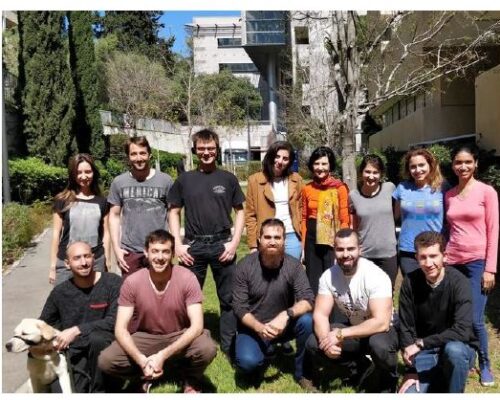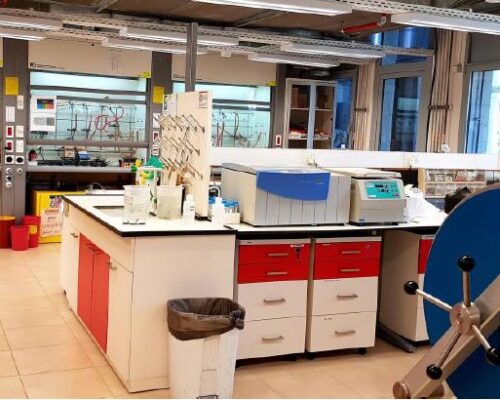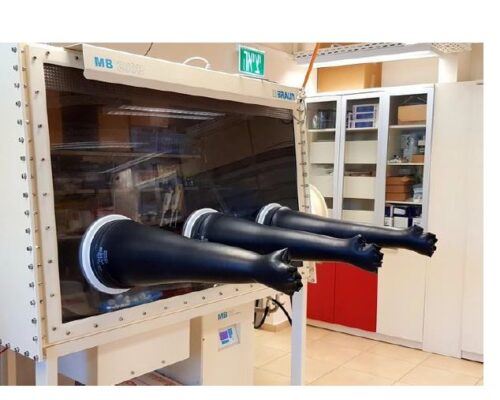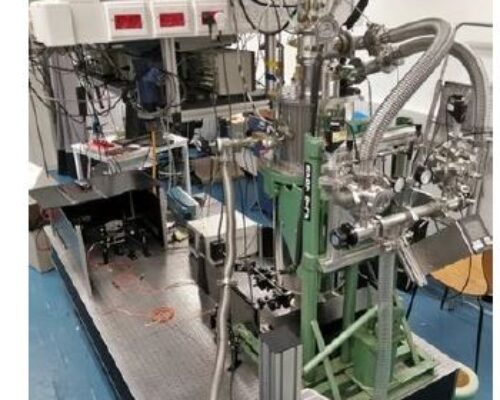Semiconductor nanostructures and dedicated magneto-optical methodologies
Prof. Lifshitz’s group is among the pioneers who initiated the exciting field of nanomaterials for nanotechnology. The group employs a multifaceted approach for the study of low dimensional semiconductor solids, with a notable contribution in the development of new materials, and moreover, in the depth of understanding of the fundamental features which govern size-related physical properties. In particularly, the group explores the correlation between intrinsic magnetic fields and optical properties of nanoparticles. The research includes the investigation of semiconductor nano-structures, which represent a class of luminescent chromophores with quantized electronic states, and tunable intense optical transitions that vary with the material’s size, shape and composition. The efforts are divided into the investigation of three different material platforms (see Scheme 1): (a) Colloidally prepared nanostructures (dots, rods, wires, platelets and polypods) from the II-VI and IV-VI families, and their corresponding core/shell hetero-structures; (b) Van der Waals materials with general chemical formula MPX3, MPX4 and M2X3 (M=transition metals, X=chalcogenides); (c) Two- and three-dimensional perovskite compounds (e.g., ABX3, A=Cs+, Ma+; B=Pb, Bi; X=halides). All mentioned materials are of a large interest for implementation in various opto-electronic, spin-electronics, memory and quantum-computation.
The pristine materials, or/and their magnetically doped derivatives, exhibit a unique combination between optical properties and magnetic effects. A few types of magnetic properties are summarized in Scheme 2: The long-range magnetic order, such as ferromagnetism, anti-ferromagnetism or special spin textures (a) are gaining special stabilization by the size confinement, with special interest in emerging technologies of spin-electronics and quantum computation; The short-range magnetic phenomena which are intrinsically developed in low dimensional materials, such as Rashba spin-orbit effect (b), nuclear spins (Overhauser effect) (c) and magnetic polarons (d). The mentioned intrinsic field leads to a lift of energy or momentum degeneracy at band-edge states, all leading to selective spin orientation at the excited state and consequent helicity of a recombination emission. The investigations are carried out by following the behavior of spins as a designation for the electronic properties, using complex optical and magneto-optical spectroscopy methodologies, including circularly polarized magneto-photoluminescence, optically detected magnetic resonance (ODMR), thermal and microwave modulated photoluminescence, all when monitoring an ensemble or a single nanostructure at variable temperatures, as well as combining microscopy and spectroscopy e.g., confocal/AFM or confocal/ODMR, some of which are home-made assemblies with a world-wide uniqueness. The experimental work is corroborated by theoretical modeling, including band structure calculations, spin interactions, Auger processes, in addition to carrier transport via small nanostructure assemblies. The accumulated knowledge is applied to development of prototype nanostructure-based devices, such as solar cells, Q-switch, optical gain, spin-filter and spin FET devices. A few exemplary fundamental projects are discussed below.
Materials
Nanostructures were produced either by colloidal chemical procedures or by vapor transport growth: (a) Colloidal quantum dots, rodes, wires, platelets of CdSe, CdTe, PbSe, PbS coated with organic ligands or by epitaxial layer of another semiconductor, known also as core-shell structures, such as PbSe/PbS, CdSe/CdS, CdTe/CdSe; (b) Colloidal nanostructures with alloyed composition, such as PbSexS1-x or PbSe/PbSexS1-x core-shell hetero-structures; (c) special efforts for the preparation of core and core/shell structures with a reduced toxicity, such as SnTe, SnTe/PbSe, InSb, In2S3; (d) Mn+2 doped core/shell nano-structures (dots, rods, nanoplatelets), placing dopants either at the core or at the shell; (e) Layered semiconductors from transition metal dichalcogenides or iodides (SnS2, PbI2, Bi2I3, In2S3) and metal phosphore-tri-chalcogenides (MPX3, M=Mn, Fe, Ni, Mg, Cd); (f) Chemically prepared Perovskites dot, rods and platelets; (g) Spray prepared nanostructures; (h), Metallic/magnetic nanostructures (g-Fe2O3); and their complex structures with CQDs; (i) Ordered or disordered packing of nanostructures, or dispersion with extremely high dilution for the isolation of a single particle.
Methodologies
Methodologies: Prof. Lifshitz’s group developed notable expertise in several distinctive methodologies combining magnetic resonance, cyclotron resonance, magnetic polarization, microwave absorption and optical spectroscopy, supplying information not revealed by conventional techniques, such as angular momentum of electronic states, g-factors, exchange interaction, Zeeman interaction, diamagnetic shift, crystal field and Rashba effects, all possessing considerable importance in understanding the physical properties of nano-scaled materials. These methodologies include the following: (a) Optically detected magnetic resonance (ODMR); (b) Microwave and thermal modulated photoluminescence; (c) Optically detected cyclotron resonance; (d) Circular polarized photoluminescence in the presence of an external magnetic field; (e) Magneto-optical confocal microscopy, when detecting the photoluminescence of isolated single nanostructure under the influence of an external magnetic field; (f) Atomic force microscopy combined with confocal microscopy for the manipulation and detection of a single nanostructure; (g) Confocal microscopy combined with magnetic resonance measurement at the excited state (viz, optically detected magnetic resonance of an isolated single nanostructure). Experimental set-up or/and representative results are depicted in Figure 1.
Theory
The electronic band structure calculations of core and core/shell quantum dot and rods were calculated, using an effective mass approximation method. A distinct treatment beyond state-of-the-art was included, considering strain effects, their relaxation by a soft boundary and graded composition around core/shell interface, finite external barrier and dielectric confinement. Later, Coulomb interactions, exchange interactions, cross section for absorption and complex Auger processes, (in collaboration with Prof. A. Efros, USA), spin alignment and polarization effect were calculated and compared with experimental results. Another study included electrical conductivity in double quantum dots, emphasizing the influence of the inter-dot distance created by the capping ligands and their influence on the connectivity properties, showing exceptional phenomena such as induced recoil or negative resistance induced by application of charge or voltage (in collaboration with Prof. U. Peskin, Technion, Israel). Most recent study, focuses on the influence of spin-orbit coupling and symmetry breaking forming the Rashba effect, which induced electronic band split and the generation of polarized transitions (in collaboration with Prof. Andrew Rappe, Pennsylvania University). The theoretical tools are implemented now a days in various current projects under consideration.
Prof. Efrat Lifshitz, earned a PhD at the University of Michigan, Ann Arbor, Michigan, USA. She did postdoctoral research at the University of Michigan as well as at the Weizmann Institute of Science, Rehovot, Israel. She joined the Technion–Israel Institute of Technology in 1990. Prof. Lifshitz holds the Matwei Gunsbuourgh Academic Chair at the Schulich Faculty of Chemistry, Technion. She is the recipient of numerous prizes, the most recent among them: The Taub Excellent in Research Prize, (2019); Lectureship speaker, Birkent University, Ankara, Turkey, (2018); Lectureship speaker, ETH, Switzerland, (2016); Israel Vacuum Society Excellence Award for Research(2016); UK-Israel Lectureship Award, Oxford University (2015); Tenne Family Prize in memory of Lea Tenne for Nanoscale Sciences, awarded by the Israel Chemical Society (2015); External Senior Fellow at the Freiburg Institute of Advanced Studies (2015). Prof. Lifshitz has published ~ 220 scientific publications including in journals with high ranking peer review, including ACS Nano, Nano Letters, Adv. Mater., PRL, PRB; invited reviews (e.g., Science 2016, Nanoscale 2016, Adv. Func.Matt. 2018); reviewed proceedings; and chapters in books. She has delivered approximately 150 invited talks at top-tier international scientific meetings (for example, MRS, E-MRS, TNT, nanoGe, GRC, QD20xx, NaNaX) and her research has been funded by assorted national agency resources, binational programs and various FP7 and Horizon2020 projects. In addition, she frequently serves on prestigious evaluation committees (ERC Advance and Synergy Grants, Cost, Wolf Prize, Israel Prize, Rothschild Foundation and binational programs). Prof. Lifshitz has also been an active partner in the establishment of the Nanotechnology and Renewable Energy Centers at the Technion and has acted as chairman or co-chairman for a variety of national and international scientific meetings.






